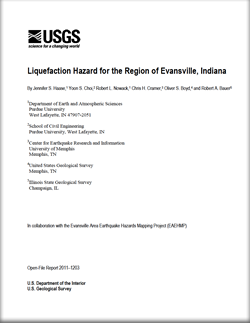 Abstract Abstract
We calculated liquefaction potential index for a grid of sites in the Evansville, Indiana area for two scenario earthquakes—a magnitude 7.7 in the New Madrid seismic zone and a M6.8 in the Wabash Valley seismic zone. For the latter event, peak ground accelerations range from 0.13 gravity to 0.81 gravity, sufficiently high to be of concern for liquefaction.
Recently acquired cone-penetrometer test data at 58 sites were used to estimate the factor of safety against liquefaction and liquefaction potential index at each site. To extend the estimation of liquefaction hazard to a grid of sites in the area, the soil columns at these grid sites were divided into three categories, and for each category a sufficient number of cone-penetrometer test sites were available to characterize statistically each group’s cone-penetrometer test tip resistance and sleeve friction. At each grid site, Monte Carlo sampling was used to generate values for these two parameters at 2-meter intervals for depths down to 20 meters or bedrock. The groundwater table at each grid site was likewise sampled from a mean value and group-dependent standard deviation. For each grid site, 25,000 realizations of the soil profile were generated and a probability distribution of liquefaction potential index values was obtained.
Maps of liquefaction hazard for each scenario earthquake present (1) Mean liquefaction potential index at each site, and (2) Probabilities that liquefaction potential index values exceed 5 (threshold for expression of surface liquefaction) and 12 (threshold for lateral spreading). Values for the liquefaction potential index are high in the River alluvium group, where the soil profiles are predominantly sand, while values in the Lacustrine terrace group are lower, owing to the predominance of clay. Liquefaction potential index values in the Outwash terrace group are less consistent because the soil profiles contain highly variable sequences of silty sand, clayey sand, and sandy clay, justifying the use of the Monte Carlo procedure to capture the consequences of this complexity.
1Department of Earth and Atmospheric Sciences
Purdue University
West Lafayette, IN 47907-2051
2School of Civil Engineering
Purdue University, West Lafayette, IN
3Center for Earthquake Research and Information
University of Memphis
Memphis, TN
4United States Geological Survey
Memphis, TN
5Illinois State Geological Survey
Champaign, IL
|
First posted September 16, 2011
This report is presented in Portable Document Format (PDF); the latest version of Adobe Reader or similar software is required to view it. Download the latest version of Adobe Reader, free of charge. |